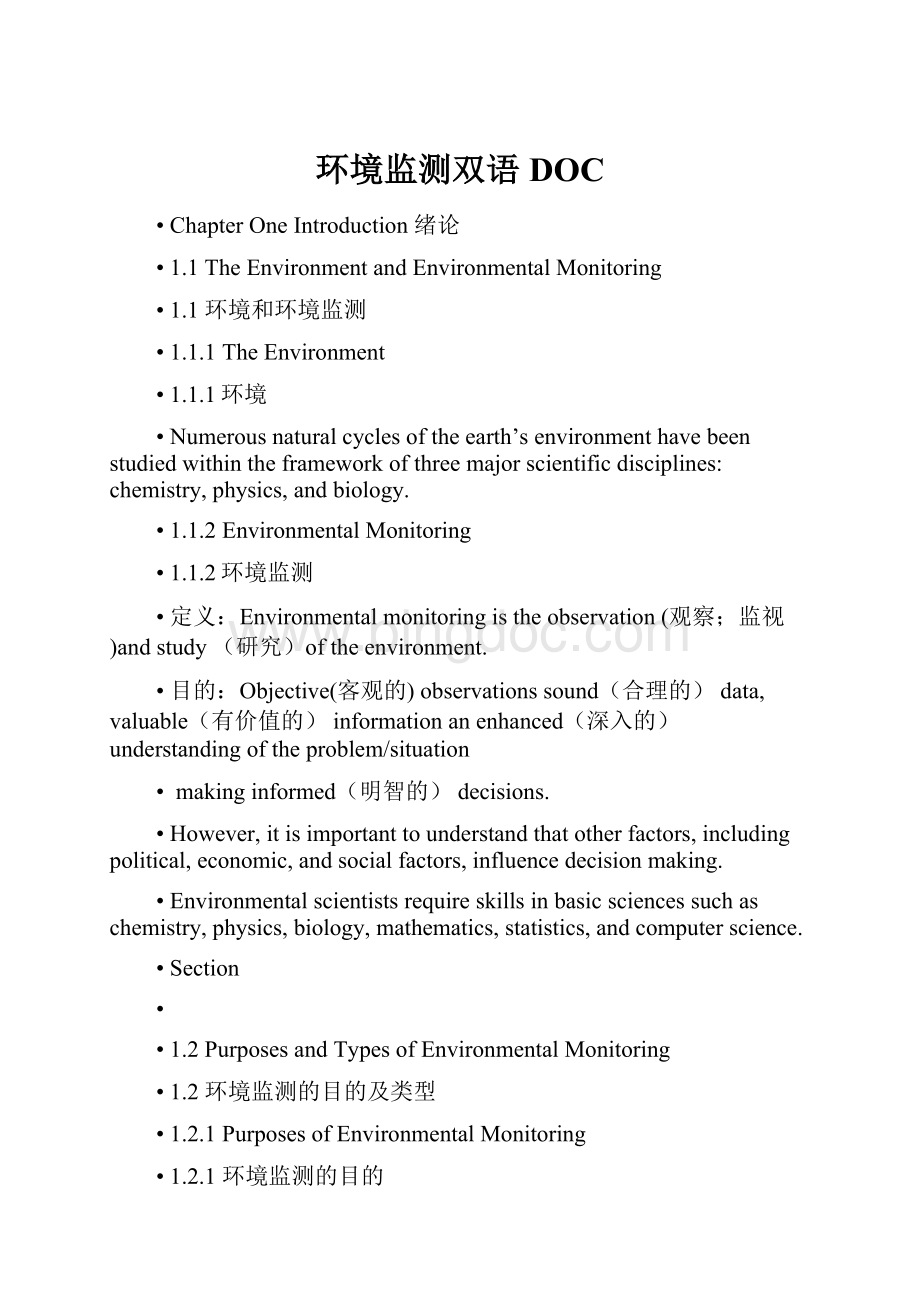环境监测双语DOC.docx
《环境监测双语DOC.docx》由会员分享,可在线阅读,更多相关《环境监测双语DOC.docx(44页珍藏版)》请在冰点文库上搜索。

环境监测双语DOC
•ChapterOneIntroduction绪论
•1.1TheEnvironmentandEnvironmentalMonitoring
•1.1环境和环境监测
•1.1.1TheEnvironment
•1.1.1环境
•Numerousnaturalcyclesoftheearth’senvironmenthavebeenstudiedwithintheframeworkofthreemajorscientificdisciplines:
chemistry,physics,andbiology.
•1.1.2EnvironmentalMonitoring
•1.1.2环境监测
•定义:
Environmentalmonitoringistheobservation(观察;监视)andstudy(研究)oftheenvironment.
•目的:
Objective(客观的)observationssound(合理的)data,valuable(有价值的)informationanenhanced(深入的)understandingoftheproblem/situation
•makinginformed(明智的)decisions.
•However,itisimportanttounderstandthatotherfactors,includingpolitical,economic,andsocialfactors,influencedecisionmaking.
•Environmentalscientistsrequireskillsinbasicsciencessuchaschemistry,physics,biology,mathematics,statistics,andcomputerscience.
•Section
•
•1.2PurposesandTypesofEnvironmentalMonitoring
•1.2环境监测的目的及类型
•1.2.1PurposesofEnvironmentalMonitoring
•1.2.1环境监测的目的
•环境监测结果既可以为环境影响评价提供依据,同时也可以监测人类活动对自然环境产生的有害影响。
•1.2.2TypesofEnvironmentalMonitoring
•1.2.2环境监测的类型
•BaselineMonitoring(基准监测)
•Asurveyshouldbeconductedonbasicenvironmentalparametersintheareasurroundingtheproposedprojectbeforeconstructionbegins(pre-auditstudy).
•基准监测就是在建筑物建筑之前对周围的环境参数进行监测。
•ImpactMonitoring(影响监测)
•Thebiophysicalandsocio-economical(includingpublichealth)parameterswithintheprojectarea,mustbemeasuredduringtheprojectconstructionandoperationalphasesinordertodetectenvironmentalchanges,whichmayhaveoccurredasaresultofprojectimplementation.
•影响监测就是在设计和施工阶段,对目标区域上的各种物理参数及社会经济参数的测定。
•ComplianceMonitoring(例行监测)
•Thisformofmonitoringemploysaperiodic(定期的)samplingmethod,orcontinuousrecordingofspecificenvironmentalqualityindicatorsorpollutionlevelstoensureprojectcompliance(符合)withrecommendedenvironmentalprotectionstandards.
•例行监测就是为了保证有关项目符合环境标准,需要对指定的项目进行定期的、长时间的监测。
•
•Section1.3ParametersofEnvironmentalMonitoring
•1.3环境监测的参数
•ChemicalParameters(化学参数)BiologicalParameters(生物参数)
•MicrobiologicalParameters(微生物参数)Population(种群)
•
•Section1.4MethodsofEnvironmentalMonitoring
•1.4环境监测的方法
•1.4.1GrabSamples
•1.4.1瞬时样品瞬时样品提供了固定时间和固定地点的环境样品质量。
如果没有附加的监测,这一结果不能推测其他时间、地点的环境水体的环境质量。
•1.4.2Semi-continuousmonitoringandcontinuous
•1.4.2半连续和连续监测
•半连续和连续监测包含了自动化、在线的分析设备,常应用于对重要水源的监测,也可用于对已存在问题河流的总体监测。
这类系统常提供的参数有PH、溶解氧、电导率、浊度及色度等,潜在有机污染物的监测可采用气相色谱与质谱联用技术。
•1.4.3RemoteSurveillance
•1.4.3远程控制
•远程控制是通过遥感网络、陆上通讯线或电话网络等将在线监测仪器与基站相连。
远程控制的优点是许多数据可以输入到一个单一的基站来储存及分析。
另外远程控制中个体的监测位置和/或参数有各自的警戒线,当其超标时可立刻查询。
在远程控制时,仪器可以分别安装,可以埋入土中、也可以伪装,比如将仪器安装在湖中或河中而只露出天线,这样可以防止人为破坏或偷盗。
•1.4.4RemoteSensing
•1.4.4遥感
•环境遥感技术就是采用航空器或卫星,通过多通道传感器来监测环境的技术。
它包括被动遥感和主动遥感。
被动遥感主要用于监测自然辐射。
而主动遥感是通过放出能量照射到目标物,采用被动传感器探测目标物反射或散射所产生的辐射。
•1.4.5Bio-Monitoring
•1.4.5生物监测
•应用生物体作为监测工具有很多优点。
生物体受环境中各种物理、化学及生物因素的影响,常能聚集环境中低浓度的物质,可用于对环境中特殊物质的分析。
•
•1.5CurrentandFutureStatusofEM
•1.5环境监测的现状及未来
•1.5.1CurrentStatusofEnvironmentalMonitoring
•1.5.1环境监测的现状
•Non-industrialcountrieshavelimitedenvironmentalresearchandfewifanyenvironmentalmonitoringprogramsrelativetoindustrializedcountries.
•不发达经济国家对对环境的研究欠缺
•Environmentaldataareoftennoteasilytransferrednorintegrated(综合的,互相协调的)。
•环境监测数据不利于转化和整合。
•Itcanalsobearguedthatuntilrecently,mostenvironmentalmonitoringprogramshavetargetedshort-termissuesrelatedonlytohumanwelfarewhileignoringlong-termchangestotheenvironment.
•此外,绝大多数的环境监测指标只注重于对人类健康的短期影响而没有考虑对环境的长期影响。
•1.5.2FutureStatusofEnvironmentalMonitoring
•1.5.2环境监测的未来
•Asthestateofscientificknowledgeadvances,sodoesourabilitytomonitortheenvironmentwithmoreefficient,accurate,andprecisetechniquesandinstrumentation.
•随着科技的进步,未来的环境监测将采用更准确的仪器、更有效的技术。
•
•
•ChapterTwoWaterandWastewaterMonitoring第二章水和废水监测
•
•Section2.1DesigningaMonitoringProgram
•2.1监测方案的制定
•Theprincipalelementsofastudyplanare:
•aclearstatementofaimsandobjectives(目标)
•informationexpectations(期望)andintendeduses
•adescriptionofthestudyareaconcerned
•adescriptionofthesamplingsites
•alistingofthewaterqualityvariablesthatwillbemeasured
•proposedfrequencyandtimingofsampling
•anestimateoftheresourcesrequiredtoimplementthedesign,andaplanforqualitycontrolandqualityassurance
•2.1.4DescriptionoftheMonitoringArea
•2.1.4监测区域描述
•Thedescriptionofamonitoringareashouldbeconsideredasaminimum:
•definitionoftheextentofthearea
•asummaryoftheenvironmentalconditionsandprocesses(includinghumanactivities)thatmayaffectwaterquality
•meteorological(气象的)andhydrological(水文学的)information
•adescriptionofthewaterbodies
•asummaryofactualandpotentialusesofwater
•2.1.5SelectingSamplingSites
•2.1.5采样断面的选择
•一监测断面的设置原则
• 应在水质、水量发生变化及水体不同用途的功能区处设置监测断面
•
(1)大量废水排入河流的居民区、工业区上下游;
•
(2)湖泊、水库的主要出入口;
•(3)饮用水源区、水资源区域等功能区;
•(4)入海河流的河口处、较大支流汇合口上游和汇合后与干流混合处;
•(5)国际河流出入国际线的出入口处;
•(6)尽可能与水文测量断面重合。
•二监测断面设置
•为评价完整江河水系的水质,需要设置背景断面、对照断面、控制断面和削减断面;对于某一河段,只需设置对照、控制和削减(或过境)三种断面。
•Backgroundsection:
basicallyunaffectedinthereachofhumanactivity,acompletewatersystemforevaluatingthedegreeofpollution
•背景断面:
设在基本上未受人类活动影响的河段,用于评价一完整水系污染程度。
•Contrastsection:
Measuringwaterbackgroundvaluesintheriverupstreamintothecityorindustrialareas。
•对照断面:
为了解流入监测河段前的水体水质状况而设置。
一个河段一般只设一个对照断面。
•Controlsection:
Measuringpollutionimpactonwaterquality,downstreamofthesewageoutfallin500-1000meters。
•控制断面:
控制断面的数目应根据城市的工业布局和排污口分布情况而定,设在排污区(口)下游,污水与河水基本混匀处。
•Cutsections:
thepurificationofpollutantsmeasuredriversituation,urbanorindustrialareasinthelast1,500metersdownstreamofasewageoutfalloftheriveroutside.
•削减断面:
是指河流受纳废水和污水后,经稀释扩散和自净作用,使污染物浓度显著降低的断面,通常设在城市或工业区最后一个排污口下游1500m以外的河段上。
•2.1.6SelectingSamplingStations
•2.1.6采样点位的选择
•设置监测断面后,应根据水面的宽度确定断面上的采样垂线,再根据采样垂线处水深确定采样点的数目和位置。
•采样点位的确定
设置监测断面后,应根据水面的宽度确定断面上的采样垂线,再根据采样垂线的深度确定采样点位置和数目。
水面宽小于50m,设一条中泓垂线;
水面宽50~100m,在左右近岸有明显水流处各设一条垂线;
水面宽100~1000m,设左、中、右三条垂线;水面宽大于1500m,至少设置5条等距离垂线。
•水深≤5m,水面下0.3~0.5m,设一个采样点;
•水深5~10m,水面下0.3~0.5m处和河底以上0.5m处各设一个;
•水深10~50m,设三个点;水面下0.3~0.5m处和河底以上0.5m处各设一个;1/2水深处一个;
•水深大于50m增加点数。
•2.1.7MonitoringVariables
•2.1.7监测项目
•监测项目受人力、物力、财力的限制,不可能将所有的监测项目都加以测定,只能是对那些优先监测污染物加以监测。
•优先监测污染物:
•标准中要求控制、在环境中难以降解;
•危害大、毒性大、影响范围广;
•出现频率高,有可靠检测方法。
•2.1.7MonitoringVariables
•2.1.7监测项目
•一地表水监测项目
•水温、pH值、溶解氧、高锰酸盐指数、化学需氧量、五日生化需氧量、氨氮、总氮(湖、库)、总磷、铜、锌、硒、砷、汞、镉、铅、铬(六价)、氟化物、氰化物、硫化物、挥发酚、石油类、阴离子表面活性剂、粪大肠菌群。
•三废(污)水监测项目
•第一类:
是在车间或车间处理设施排放口采样测定的污染物,包括总汞、烷基汞、总镉、总铬、六价铬、总砷、总铅、总镍、苯并(a)芘、总铍、总银、总α放射性、总β放射性。
•第二类:
是在排污单位排放口采样测定的污染物,包括pH、色度、悬浮物、生化需氧量、化学需氧量、石油类、动植物油、挥发性酚、总氰化物、硫化物、氨氮、氟化物、磷酸盐、甲醛、苯胺类、硝基苯类、阴离子表面活性剂、总铜、总锌、总锰。
•Section2.2FieldWorkandSampling
•2.2现场工作及采样
•2.2.1SampleContainers
•2.2.1水样容器
•glasscontainersplasticcontainers
•2.2.2TypesofSample
•2.2.2水样类型
•Samplingsurfacewaters
•Thesimplest,a“grab”sample,istakenataselectedlocation,depthandtime.
•Compositeorintegratedsamplesrefertosamplesmadeupofseveraldifferentparts,whichareoftenneededtofulfilsomespecificmonitoringobjectives.
•Compositesamplesmaybeofthefollowingtypes:
•Depth-integrated:
mostcommonlymadeupoftwoormoreequalpartscollectedatpredetermineddepthintervalsbetweenthesurfaceandthebottom.
•Area-integrated:
madebycombiningaseriesofsamplestakenatvarioussamplingpointsspatiallydistributedinthewaterbody.
•Time-integrated:
madebymixingequalvolumesofwatercollectedatasamplingstationatregulartimeintervals.
•Discharge-integrated:
isfirstnecessarytocollectsamplesandtomeasuretherateofdischargeatregularintervalsovertheperiodofinterest.Acommonarrangementistosampleevery2hoursovera24-hourperiod.Thecompositesampleisthenmadebymixingportionsoftheindividualsamplethatareproportionaltotherateofdischargeatthetimethesamplewastaken.
2.2.3WaterSamplers
2.2.3水采样器
•2.2.4ManualSamplingProcedures
•2.2.4人工采样过程
Thefollowinggeneralguidelinescanbeappliedtothecollectionofwatersamplesfromriversandstreams,lakesorreservoirsandgroundwater.
•Beforecollectinganysample,makesurethatyouareattherightplace.
•Donotincludelarge,non-homogeneouspiecesofdetritus,suchasleaves,inthesample.
•Samplingdepthismeasuredfromthewatersurfacetothemiddleofthesampler.
•Samplestakentodescribetheverticalprofileshouldbetakeninasequencethatstartsatthesurfaceandfinishesatthebottom.
•Donotloweradepthsamplertoorapidly.
•Abottlethatistobeusedfortransportorstorageofthesampleshouldberinsedthreetimeswithportionsofthesamplebeforebeingfilled.
•Thetemperatureofthesampleshouldbemeasuredandrecordedimmediatelyafterthesampleistaken.
•Thesampletobeusedfordissolvedoxygendeterminationshouldbepreparedimmediatelyafterthetemperatureismeasured.
•SeparateportionsofthesampleshouldbesetasideforpHandconductivitydeterminations.
•Atanytimethatthesamplebottlesarenotclosed,theirtopsmustbekeptinacleanplace.
•Asmallairspaceshouldbeleftinthesamplebottletoallowthesampletobemixedbeforeanalysis.
•Allmeasurementstakeninthefieldmustberecordedinthefieldnotebookbeforeleavingthesamplingstation.
•Allsupportinginformationshouldberecordedinthefieldnotebookbeforeleavingthesamplingstation.
•Samplesshouldbetransferredtosample